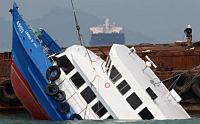 Update: The death toll from the ferry collision has risen to 39 after a nine year old girl, Tsui Hoi-ying, who had been of life support in a Hong Kong hospital, is reported to have died.
Update: The death toll from the ferry collision has risen to 39 after a nine year old girl, Tsui Hoi-ying, who had been of life support in a Hong Kong hospital, is reported to have died.
It only took about two minutes for the ferry Lammna IV to sink in Hong Kong harbor off Victoria after being struck by another ferry boat around 8pm October 1st. Of the more than 120 passengers on the Lammna IV, 38 are believed to have drowned. It was the worst harbor accident in Hong Kong in more than 40 years.
How could the ferry have sunk so fast? Currently, there are far more questions than answers. The Lammina IV was built of fiberglass by Cheoy Lee Shipyard in 2003. The other ferry, the Hong Kong ferry The Smooth Sea, is built of aluminum. Both vessels were believed to be traveling at close to their full speed of 15-20 knots at the time of the collision. Two water tight bulkheads are believed to have ruptured in the collision, rapidly flooding the stern of the ferry causing it to sink rapidly with its bow pointed skyward. There is some question as to whether the watertight doors in these bulkheads were open which would have accelerated the rate of the flooding.
Why the Lamma IV sank so quickly
Seven officers and crew from both ferry boats have been arrested. The investigation into the tragic accident is expected to take six months.
Thanks to Christina Sun and Phil Leon for contributing to the post.

When I first read the caption “Sink” I assumed submerged completely. This was not the case, some watertight bulkheads did hold and the Lammna IV did not completely sink. Perhaps flooded or swamped would be a better description?
What occurred is the result of catastrophic flooding of perhaps two, three, or four watertight compartments. The usual subdivision rules would require reasonable stability in the event of one compartment being flooded.
Technically, you are exactly right. The ferry did not fully sink. Her bow appears be floating, with the prow pointing skyward, at close to vertical, with the majority of the ferry deeply underwater. The only problem with describing the ferry as “flooded” or “swamped” is that it doesn’t capture the severity of the damage.
Right Rick, the BBC used “half-sunk”, which is awkward but sort of accurate.
While I am glad to see that the WT bulkheads did their job and it may have been a lifesaver for those in the forward main deck area, overall it does not look that great. The only remedy I can think of this morning is double side tanks for these high-speed vessels, or perhaps some form of smaller WT divisions.
The results of the inquiry will be interesting. From the published reports, it sounds like the transom and at least one after bulkhead were breached in the collision. If so the regulators might want to look more closely at the strength of the rear collision bulkhead. Some have also suggested that one or more watertight doors were left open, which would shift the focus from design to operations. We may, or may not, have an answer in six months.